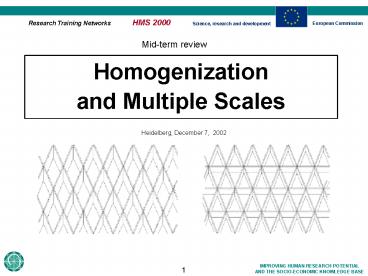Homogenization and Multiple Scales
1 / 16
Title: Homogenization and Multiple Scales
1
Homogenizationand Multiple Scales
Mid-term review
Heidelberg, December 7, 2002
2
PART A - RESEARCH RESULTSA.1 Scientific
Highlights
- There are 4 main research areas in the project
1. Quasiconvexity including derivation of the
quasiconvex hull of martensitic sets and
attainment application of quasiconvexity in
homogenization and optimal design.
2. Homogenization of partial differential
equations including homogenization of systems
with special geometries as truss-like and
perforated structures, or problems with
oscillating boundaries homogenization of non
linear systems non-local effects.
3. Relaxation techniques for optimal design
including shape optimization relaxed and
classical solution optimal design and
homogenization.
4. Numerical methods, including numerical
computation of microstructures for
non-quasiconvex problems numerical methods
related to homogenization of partial differential
equations numerical schemes for advanced shape
design problems
3
A.2 Joint publications
More than 60 publications have been listed in the
review report, of which more than 25 involve
young researchers.
4
PART B - COMPARISON WITH THE PROJECT PROGRAMME
(Annex I)
B.1 Project Objectives
The research objectives, as set down in the
project programme are still very relevant and
achievable.
B.2 Research Method and Work Plan
The methodological approach has not changed from
that described in the contract.
5
B.4 Research Effort of the Participants
Professional research effort on the network
project cumulative for first and second year
6
B.5 Networking Activities Schools and
conferences
1- Créteil 12 January 2001 First coordinators
meeting. Included a full day of scientific
presentations
2- Napoli School 18-22 June 2001 (programme) A
week of lectures for the young researchers
3- Napoli Conference 23-27 June 2001 followed
the School.
4- Timisoara (15-19 September 2001) A major
Conference of the Network.
5- Université d'Amiens A full day special
meeting, 14 January 2002 Journée
Homogénéisation et Applications
6- Oberwolfach Seminar on Multiscale Problems
(Front Propagation, Homogenization for First- and
Second-Order PDEs, and Applications) in November
2001
7- Journées de Metz Homogénéisation, progrès
récents et applications (3-5 April 2002) A
conference held with support from the Network
8- School in Heidelberg (24-27 April 2002) A
school for young researchers
9- Young Researchers' Workshop (Copenhagen, May
31-June 2, 2002) this workshop was organized by
the young researchers for the young researchers
themselves.
7
B.6 Network Organisation and Management
Extensive e-mail exchanges. The advertising for
positions via a mailing list from each node, as
well as via the Network web site. At each
meeting of the Network, a coordinators meeting
is also organized. Other coordinators meetings
took place Madrid February 23, 2001 Madrid
March 1-2, 2002
We are setting up an event page on the web site,
and plan on having a publication server running
by the end of the Winter.
8
B.7 Cohesion with Less Favoured Regions and
Associated States
Romania is an associated state and a member of
HMS 2000. Every effort (including faxing visa
forms,) has been made to integrate the Romanian
side into the Network. Several of the young
researchers come from Romania, and one of the
Networks main Conferences was organized in
Romania (Timisoara).
9
B.8 Connections to Industry
Three nodes have industrial connections which
have been useful for the whole network DK, DE,
RO, CH
10
PART C - TRAININGC.1 Appointment of Young
Researchers
11
C.2 Training Programme
The training programme is based on young
researchers appointments with at least one group.
We are now getting to the point where many of
the young researchers are receiving a second
appointment with another group. The idea is that
they receive both a theoretical and an applied
training.
12
C.3 Factual Information on the Young Researchers
13
PART D - SKETCHES OF THE YOUNG RESEARCHERS
Will be provided in written form today!
14
PART E - NETWORK FINANCING
Approximate share of networking costs
specifically dedicated to Young Researchers
15
Here is the percentage of actual expenditure with
respect of forecast expenditure
16
Comparison with contract
Percentage of Training costs vs overall (should
be over 60)
Percentage of overhead cost vs Training
Networking (should be less than 20)































